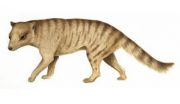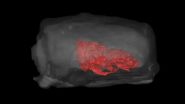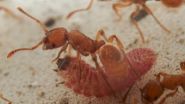(Press-News.org) This news release is available in French.
University of Montreal researchers have discovered how a component of the Epstein Barr (EBV) virus takes over our cells gene regulating machinery, allowing the virus to replicate itself. The EBV virus causes a variety of diseases such as Hodgkin's lymphoma and Burkitt's lymphoma, with the most prevalent disease being infectious mononucleosis commonly known as "kissing disease" because of its mode of transmission between humans. It turns out that the diseases begin with kiss of a molecular sort; a viral protein contacting the molecules that control our genes.
Viruses such as EBV use sophisticated strategies to subvert human cells during an infection. The viruses cannot survive outside of human cells and for this reason they have developed strategies to mimic key components of human cell function such as the RNA polymerase. "Unraveling the atomic level details of these interactions using structural biology allows us to understand how the virus tricks the human defense systems. Having this knowledge is the first step towards developing new therapeutic treatments for viral infections", explained Dr. James Omichinski, senior author of this work conducted in collaboration with his colleague Dr. Jacques Archambault at the Institut de recherches cliniques de Montréal (IRCM).
Using cutting-edge nuclear magnetic resonance techniques at the University of Montreal facility for structural biology in the Department of Biochemistry and Molecular Medicine, the scientists studied how the EBNA2 protein of the EBV virus binds to one of the proteins of the TFIIH complex that helps regulate another protein called RNA polymerase II, a molecule that is responsible for the control of most of our genes. "We were able to unravel the molecular details of the interaction between these proteins", explains Dr. Omichinski.
To unravel the molecular details of this interaction, the lead author Philippe Chabot labeled the EBNA2 protein and TFIIH with stable isotopes and determined the molecular structure of their interaction using NMR spectroscopy. "This type of instrumentation costs several millions dollars, but thanks to generous investments made by the Canada Foundation for Innovation (CFI) we are able to conduct such studies with the most modern equipment", explained Dr. Omichinski. A direct benefit of this work is that the "kissing" interaction between EBNA2 proteins and TFIIH could be a target for drug development to better treat kissing disease and cancers caused by EBV viruses in future.
INFORMATION:
Notes:
The University of Montreal is known officially as Université de Montréal. The research involved in the study "Structural and Functional Characterization of a Complex between the Acidic Transactivation Domain of EBNA2 and the Tfb1/p62 Subunit of TFIIH" was financed by the Canadian Institutes of Health Research grant MOP-74739 to J. Omichinski, Cancer Society grant #19630 (J. Omichinski), the Cancer Research Society (J. Archambault), and by the CREATE training program in "Cellular dynamics of macromolecular complexes". The study was published in PLOS Pathogens.
Researchers discover how the kissing disease virus hijacks human cells
University of Montreal scientists discover molecular details of kissing disease virus attacks
2014-04-10
ELSE PRESS RELEASES FROM THIS DATE:
Periodontal disease associated with cardiovascular risk in large multicenter study
2014-04-10
Sophia Antipolis, 10 April 2014. Periodontal disorders such as tooth loss and gingivitis have been identified as a potential risk marker for cardiovascular disease in a large study reported today.(1) More than 15,000 patients with chronic coronary heart disease provided information on their dental health, with results showing that indicators of periodontal disease (fewer remaining teeth, gum bleeding) were common in this patient group and associated with numerous cardiovascular and socioeconomic risk factors.
Conversely, a lower prevalence of tooth loss was associated ...
Breastfeeding and infant sleep
2014-04-10
In a new article published online today in the journal Evolution, Medicine, and Public Health, Professor David Haig argues that infants that wake frequently at night to breastfeed are delaying the resumption of the mother's ovulation and therefore preventing the birth of a sibling with whom they would have to compete.
It has already been documented that smaller gaps between the births of siblings are associated with increased mortality of infants and toddlers, especially in environments where resources are scarce and where infectious disease rates are high, and Professor ...
Extinct carnivorous marsupial may have hunted prey larger than itself
2014-04-10
The reconstruction of an extinct meat-eating marsupial's skull, Nimbacinus dicksoni, suggests that it may have had the ability to hunt vertebrate prey exceeding its own body size, according to results published April 9, 2014, in the open access journal PLOS ONE by Marie Attard from the University of New England together with colleagues from the University of New South Wales.
Nimbacinus dicksoni is a member of an extinct family of Australian and New Guinean marsupial carnivores, Thylacinidae. Aside from one recently extinct species, the majority of information known about ...
Rare leafcutter bee fossils reveal Ice Age environment at the La Brea Tar Pits
2014-04-10
VIDEO:
This is a spinning animation of fossil of male pupa and its position within the nest cell.
Click here for more information.
LOS ANGELES — The La Brea Tar Pits, the world's richest and most important Ice Age fossil locality, is most celebrated for it collection of saber-toothed cats and mammoths. The site's lesser known, but equally vast insect collection, is also of great significance. Recent examination of fossil leafcutter bee nest cells containing pupae, led by Anna R. ...
Spironolactone not reduce primary outcome, did reduce hospitalizations for heart failure
2014-04-10
Boston, MA – Findings from the Treatment of Preserved Cardiac Function Heart Failure with an Aldosterone Antagonist (TOPCAT) trial, have revealed that adding the medication known as spironolactone (Aldactone) to existing therapy did not significantly reduce the composite time to either death from cardiovascular causes, surviving a cardiac arrest, or hospitaliization to manage heart failure in patients with heart failure and a preserved ejection fraction in a study funded by the National Heart, Lung and Blood Institute, National Institutes of Health.
The study will be ...
Study confirms impact of clinician-patient relationship on health outcomes
2014-04-10
A meta-analysis of studies that investigated measures designed to improve health professionals' interactions with patients confirms that such efforts can produce health effects just as beneficial as taking a daily aspirin to prevent heart attack. In contrast to previous such reviews, the current report from the Empathy and Relational Science Program at Massachusetts General Hospital (MGH) only included randomized, controlled trials with more reliable results than those included in earlier studies. While it has long been believed that a good patient-clinician relationship ...
Water users can reduce the risk of spreading invasive species
2014-04-10
Foreign species that are devastating water ecosystems could be "hitchhiking" around Britain on canoeists' and anglers' kit, according to a new study.
Invaders like the killer shrimp, zebra mussel and American signal crayfish have already caused extensive environmental damage and millions of pounds of economic costs.
The new research, led by the University of Leeds and the Centre for Environment Fisheries and Aquaculture Science (Cefas), found that the cleaning habits of anglers and canoeists could be a key part of the problem.
The study, based on a survey of more ...
Butterfly larvae mimic queen ant to avoid detection
2014-04-10
Parasitic butterfly larvae may mimic ants' acoustic signals to aid in the infiltration of their host colonies, according to results published April 9, 2014, in the open access journal PLOS ONE by Marco Sala from University of Turin, Italy, and colleagues.
Ants aggressively defend their colonies and nests, so successfully that these locations make a perfect shelter for another similar species to live in. However, ants have evolved a complex set of signals that allow colony members to distinguish between residents and intruders. The social parasitic Maculinea butterfly uses ...
Security barriers in US/Mexico national parks affect movement of animals
2014-04-10
Because international boundaries can be focal points for trade, illegal activity and development, national parks in their vicinity can be vulnerable to pollution, erosion and hunting as well as smuggling of people and drugs.
There is an increasing trend towards the erection of barriers to counter this illegal activity, which may reduce environmental impacts too. However barriers may restrict native species' territory, causing an environmental impact of their own.
Bristol PhD student, Jamie McCallum, now of the Zoological Society of London (ZSL), and colleagues from ...
Genetic defect may confer resistance to certain viral infections
2014-04-10
WHAT:
A National Institutes of Health (NIH) study reports that a rare genetic disease, while depleting patients of infection-fighting antibodies, may actually protect them from certain severe or recurrent viral infections. Researchers found that HIV and influenza viruses replicate in the cells of people with congenital disorder of glycosylation type IIb (CDG-IIb) at a much lower rate than in healthy donor cells, creating fewer and less infectious viruses. The study, published in The New England Journal of Medicine, was led by Sergio Rosenzweig, M.D., Ph.D., director of ...
LAST 30 PRESS RELEASES:
Heart-brain connection: international study reveals the role of the vagus nerve in keeping the heart young
Researchers identify Rb1 as a predictive biomarker for a new therapeutic strategy in some breast cancers
Survey reveals ethical gaps slowing AI adoption in pediatric surgery
Stimulant ADHD medications work differently than thought
AI overestimates how smart people are, according to HSE economists
HSE researchers create genome-wide map of quadruplexes
Scientists boost cell "powerhouses" to burn more calories
Automatic label checking: The missing step in making reliable medical AI
Low daily alcohol intake linked to 50% heightened mouth cancer risk in India
American Meteorological Society announces Rick Spinrad as 2026 President-Elect
Biomass-based carbon capture spotlighted in newly released global climate webinar recording
Illuminating invisible nano pollutants: advanced bioimaging tracks the full journey of emerging nanoscale contaminants in living systems
How does age affect recovery from spinal cord injury?
Novel AI tool offers prognosis for patients with head and neck cancer
Fathers’ microplastic exposure tied to their children’s metabolic problems
Research validates laboratory model for studying high-grade serous ovarian cancer
SIR 2026 delivers transformative breakthroughs in minimally invasive medicine to improve patient care
Stem Cell Reports most downloaded papers of 2025 highlight the breadth and impact of stem cell research
Oxford-led study estimates NHS spends around 3% of its primary and secondary care budget on the health impacts of heat and cold in England
A researcher’s long quest leads to a smart composite breakthrough
Urban wild bees act as “microbial sensors” of city health.
New study finds where you live affects recovery after a hip fracture
Forecasting the impact of fully automated vehicle adoption on US road traffic injuries
Alcohol-related hospitalizations from 2016 to 2022
Semaglutide and hospitalizations in patients with obesity and established cardiovascular disease
Researchers ‘listen in’ to embryo-mother interactions during implantation using a culture system replicating the womb lining
How changing your diet could help save the world
How to make AI truly scalable and reliable for real-time traffic assignment?
Beyond fragmented markets: A new framework for efficient and stable ride-pooling
Can shape priors make road perception more reliable for autonomous driving?
[Press-News.org] Researchers discover how the kissing disease virus hijacks human cellsUniversity of Montreal scientists discover molecular details of kissing disease virus attacks



